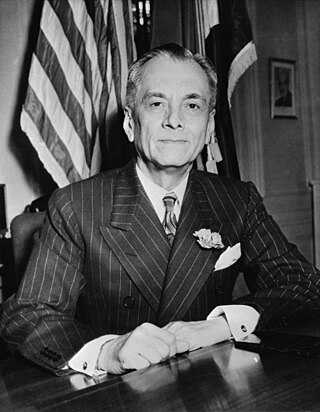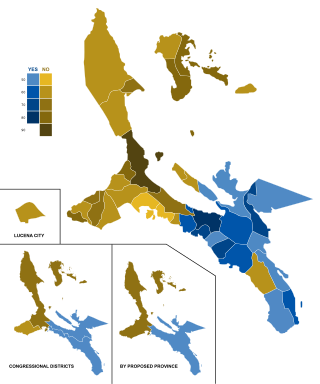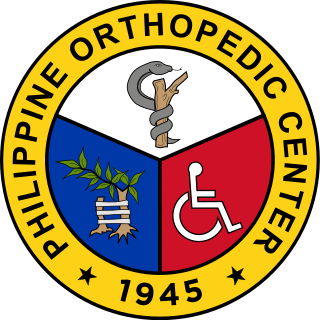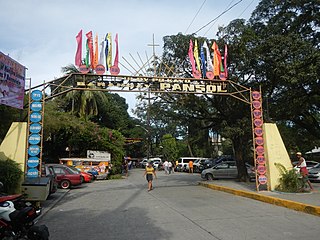
Metropolitan Manila, commonly shortened to Metro Manila and formally the National Capital Region, is the capital region and largest metropolitan area of the Philippines. Located on the eastern shore of Manila Bay, the region lies between the Central Luzon and Calabarzon regions. Encompassing an area of 619.57 km2 (239.22 sq mi) and with a population of 13,484,462 as of 2020, it is composed of sixteen highly urbanized cities: the capital city, Manila, Caloocan, Las Piñas, Makati, Malabon, Mandaluyong, Marikina, Muntinlupa, Navotas, Parañaque, Pasay, Pasig, Quezon City, San Juan, Taguig, and Valenzuela, along with one independent municipality, Pateros. As the second most populous and the most densely populated region in the Philippines, it ranks as the 9th most populous metropolitan area in Asia and the 6th most populous urban area in the world.

The Commonwealth of the Philippines was an unincorporated territory and commonwealth of the United States that existed from 1935 to 1946. It was established following the Tydings–McDuffie Act to replace the Insular Government of the Philippine Islands and was designed as a transitional administration in preparation for full Philippine independence. Its foreign affairs remained managed by the United States.

Manuel Luis Quezon y Molina, also known by his initials MLQ, was a Filipino lawyer, statesman, soldier, and politician who was president of the Commonwealth of the Philippines from 1935 until his death in 1944. He was the first Filipino to head a government of the entire Philippines and is considered the second president of the Philippines after Emilio Aguinaldo (1899–1901), whom Quezon defeated in the 1935 presidential election.

Southern Tagalog, designated as Region IV, was an administrative region in the Philippines that comprised the current regions of Calabarzon and Mimaropa, the province of Aurora in Central Luzon, and most of the National Capital Region. It was the largest region in the Philippines in terms of both land area and population. After its partition on May 17, 2002, Southern Tagalog continues to exist as a cultural-geographical region.

Quezon City, also known as the City of Quezon and Q.C., is the most populous city in the Philippines. According to the 2020 census, it has a population of 2,960,048 people. It was founded on October 12, 1939, and was named after Manuel L. Quezon, the second president of the Philippines.

Central Luzon, designated as Region III, is an administrative region in the Philippines, primarily serving to organize the 7 provinces of the vast central plains of the island of Luzon, for administrative convenience. The region contains the largest plain in the country and produces most of the country's rice supply, earning itself the nickname "Rice Granary of the Philippines". Its provinces are: Aurora, Bataan, Bulacan, Nueva Ecija, Pampanga, Tarlac and Zambales. Pangasinan was formerly a province of Central Luzon before President Marcos signed Presidential Decree No. 1, 1972, incorporating it into Ilocos Region. Additionally, the province of Aurora was part of the defunct political region Southern Tagalog when the region was divided into Calabarzon and Mimaropa, upon the issuance of Executive Order No. 103, dated May 17, 2002, by then-President Gloria Macapagal Arroyo, which transferred Aurora to Central Luzon.

Rodriguez, officially the Municipality of Rodriguez, is a 1st class urban municipality in the province of Rizal, Philippines. According to the 2020 census, it has a population of 443,954 people making it the most populous municipality in the country. Pending an affirmation through plebiscite, Republic Act No. 11812 repealed Batas Pambansa Blg. 275 and intend to revert to its original municipal name Montalban.

Baler, officially the Municipality of Baler, is a 3rd class municipality and capital of the province of Aurora, Philippines. According to the 2020 census, it has a population of 43,785 people.

Lucena, officially the City of Lucena, is a 1st class highly urbanized city in the Calabarzon region of the Philippines. It is the capital city of the province of Quezon where it is geographically situated but, in terms of government and administration, the city is politically independent from the province. For statistical and geographical purposes, Lucena is grouped with the province of Quezon. According to the 2020 census, it has a population of 278,924 people.

Tiaong, officially the Municipality of Tiaong, is a first-class municipality in the province of Quezon, Philippines. According to the 2020 census, it has a population of 106,265 people.

The legislative districts of Quezon City are the representations of the highly urbanized city of Quezon in the various national and local legislatures of the Philippines. At present, the province is represented in the House of Representatives of the Philippines by its six congressional districts, with the districts' representatives being elected every three years. Additionally, each district is allotted six seats in the Quezon City Council, creating a total of thirty-six elective seats in the legislature.
The legislative districts of Aurora are the representations of the province of Aurora in the various national legislatures of the Philippines. The province is currently represented in the lower house of the Congress of the Philippines through its lone congressional district.

The legislative districts of Quezon are the representations of the province of Quezon and the highly urbanized city of Lucena in the various national legislatures of the Philippines. The province and the city are currently represented in the lower house of the Congress of the Philippines through their first, second, third, and fourth congressional districts.

The Veterans Memorial Medical Center was established in 1955 with full US Government assistance under the US Veterans Administration to provide quality hospitalization, medical care and treatment to Filipino veterans as provided by U.S. public law. The patients were originally those who suffer from service-connected disabilities arising from their services with the USAFFE, recognized guerrilla units, Philippine Scouts, and Philippine Commonwealth Army, which was later extended to AFP retirees and their dependents.

The Quezon del Sur creation plebiscite was a plebiscite on the creation of the province of Quezon del Sur from Quezon; the original Quezon province would have been renamed to "Quezon del Norte" had the plebiscite been approved by the residents of Quezon. The plebiscite was held on December 13, 2008, and the result was a slight majority rejecting the creation of the province.

The Philippine Orthopedic Center is a 700-bed tertiary special hospital under the Department of Health of the Philippines, specializing in the treatment of musculoskeletal disorders and serves as a center for trauma and orthopedics. The hospital is located at Banawe Avenue corner Maria Clara Street, Santa Mesa Heights, Quezon City.

The National Kidney and Transplant Institute is a tertiary referral hospital located in Central, Quezon City, Philippines. The hospital opened on January 16, 1981.

The East Avenue Medical Center (EAMC) is a government-owned tertiary general hospital located in Central, Quezon City, Philippines.

Pansol is a barangay of Quezon City. According to the 2020 Census, it has a population of 35,254 people.

The National Children's Hospital is a tertiary health facility in Quezon City, Metro Manila, Philippines. It is a 250-bed capacity training and specialty hospital.



















